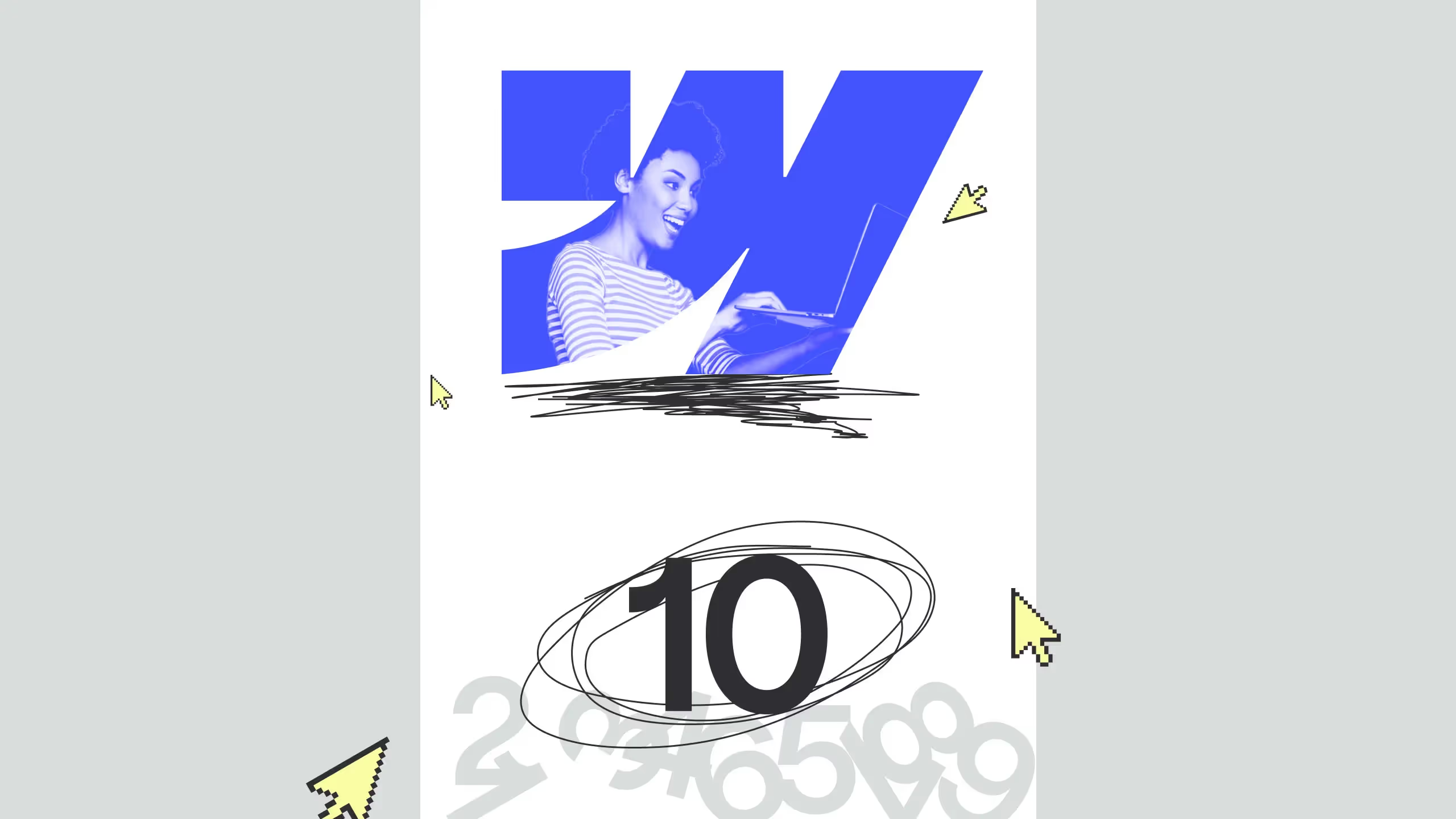
Animation has become one of the most powerful tools in modern web design. It captures attention, communicates ideas visually, and makes websites more interactive and enjoyable to use. By adding motion to typography, backgrounds, data, and interfaces, designers can guide users, simplify complex information, and enhance the emotional connection between brand and visitor.
From subtle micro-interactions to full background motion, every animated element serves a purpose, to inform, engage, or delight. Smart animation design not only improves aesthetics but also supports usability, storytelling, and brand perception. When used thoughtfully, it turns static layouts into living experiences that hold users’ attention and inspire action.
In the design process, there is an incredible number of elements that build a bigger picture. The image, logo, website, the entire visual presentation of the brand that designers make are all glittering gems that attract people's attention!
The looks of these images and concepts look have a purpose and convey some idea or message. However, how much detail does it take to put together a good design image? And what are the strongest elements that make up a whole image with a strong visual message and a powerful look?
Today we single out one of them for you - animation.
Animation
A moving image - that's probably the first thing that comes to mind when you think about animation! Talking about it, at first, you will probably think of animated goofy-looking cartoons.
However, animation can be a movement of any element on the website - images, text, typography, etc. Expert designers have long tried to animate various components of the website, and it has proven to be very effective. Of course. How could it not be when we humans are mostly visual beings!
It means that we primarily rely on the sense of sight, and that is the reason why we react well to visual design products. And why everyone loves to see them. Because our eye reacts quickly to movement, the animation captivates us almost immediately! And not only that. We simply like to observe what is happening, where the object is moving, and what it will do next!
Due to that, the animated content very easily became a powerful tool of design. Naturally, it conquered the platforms where it is necessary to attract the attention of the audience. In other words, it has become popular in the designs for the advertising of companies and individuals. That's why it is so important for you to learn about all the potentials of animation! Today, we will tell you where to add a little motion and when to use animated content on the website.
Stay with us for 6 tips and tricks that will help you engage users with animation!

1. Draw attention with animation
As we have already explained, simple movement will make people look that way. If an element somehow moves on a website page, it will unmistakably grab the User’s attention. And what you need to know is - which elements to animate.
Simply put, what you could animate is exactly the essential information you want to convey to the User.
For starters, this can be something that will automatically attract attention, such as headings. Headings should be attractive in terms of content and appearance, so don't be afraid to add animation to an element that accompanies the headings or animate typography itself!
Animated typography is a great tool to get the User interested in reading what you have to say. The letters on the move will grab their attention, and they will focus on that specific part of the page. In a similar way, you can add animation to the design elements that should interact with the User.
Interactive forms should probably lead the User to something you offer, and that is why it is smart to add animation here. You can make micrographic animations that will be interesting to the User while passing through the content. You can also include animations that slowly reveal the hidden part of the page or content. Users like this because they gradually discover the content, and the whole experience with the animation is even better!
You can then include many small animated objects that will keep the User busy. The point is that your animated content works together with the User to easily guide them through your site and highlight the most relevant info. That's why you should be smart when adding animation! Put it in places where you want the User to focus, do or discover something. At the end of the action, you can add an animated element that will cheerfully give feedback or thank the User. Those are things that are valued!

2. Animate products and services
If you work on a site that sells some products - turn the pages into a real store! Show Users how products and services look in the form of a photo or illustration. That will surely interest them further. As expected, here too, animations play a big role! The products that rotate and move act vividly and bring the User closer to the whole idea. Objects that Users can rotate and take a good look at before they decide to buy them are not only interesting but look really professional.
You can do the same for services offered by a company, agency, or individual. Animating an activity in a very easy way explains to the User what the service itself looks like. If you allow the User to participate by clicking on certain parts of the animation, the whole experience will be even better. Users appreciate this almost-as-real-life situation and often have more confidence in the company because of the animated displays.
So don’t hesitate to add motion to items! It will show how you do your job and make the User an active participant. Good examples of useful animation are carousels - moving slides. They are now one of the most popular ways to display offers in moving pictures, especially if the User can move them on their own.

3. Explain with animation
Animated content can convey a lot of information without burdening the visitor. And that is its best feature! If you want to describe or explain something special to people, you can do it through text or graphics. However, if the content is more complex and longer, it is best to transfer it visually, with some video tutorials and animated content.
Animation in explanations through image and video guides the User through the whole experience. Elements such as arrows, lines, pointers, and the like emphasize the important things that the User needs to think about! That's why animations mix with other media, images, graphics, and videos!
When people see animation in the video, they pay extra attention, and that is why it works as a great addition to the whole content. In addition, it will keep the attention of anyone who comes across a serious guide. Therefore, you should try to make the animated elements original and interesting. That will facilitate the processing of some more serious content.
Make these pop-up moving objects and thumbnails trendy and in line with the brand of the site. That will help the audience to connect more emotionally with the content!

4. Data animation
When it comes to data analytics, statistics, and other info related to the work and success of the company, it is content that is not so interesting to everyone. We are talking, of course, about very important data, such as sales success, business development, site traffic, etc. So we are talking about numbers, charts, and tables that hold valuable information for anyone who has a site.
However, many users want to have some insight into statistics and analysis of the site and the company. That is especially the case when the User on the site needs to buy something or wants to cooperate with the site owner. That is why it is always useful when the site has these important data in a separate section.
As this can be content that takes longer to analyze and looks more serious, it can tire a visitor who would like to learn more about statistics. Therefore, these data analyzes must be presented in a clear and concise manner. Images, graphics, color charts, additional visual explanations, and of course - animation help here.
Animating data will draw much more attention to these essential data than when they stand alone as a pile of numbers and text. Animation can stand next to some of the most relevant information, it can relieve the content by revealing part by part and the like. In any case, it would be much more interesting for everyone to read about statistics that would be in some way animated and interactive.

5. Background animation
Make everything much more dynamic!
When we talk about animated content on the background of the site, we are talking about an explosion of creativity! Many designers have noticed that the animation tells the User that something is happening in a certain place on the site. Often, the animation itself invites the User to action, which is a great way for the site to communicate with its audience. However, you can use this dynamic image and moving object for aesthetics and atmosphere as well.
Many sites today have a lively and changing background that is moving. The animated background attracts and maintains the attention of any visitor and creates an atmosphere following the style of the site.
Slow or fast movements, circular and straight paths, objects with a pleasant loop, floating elements - all these are web design items that will tuck the User into the experience and introduce him to the brand of the site.
Use the background to relax the observer or to invite him to action and interaction. Always keep in mind that animation, even in the background, plays a big role. It indirectly influences the User experience and gives life to the ideas of the brand and the company.

6. Loading animation
Use animation in a whole new way! Loading animation is something that people just adore today! Why? Because it eases the tedious process of loading the page.
Of course, we do not recommend that you create pages that will take a long time to load. That is a very bad thing for a website because visitors just don't like to wait long! However, if there are parts that (acceptably) take a longer time to load, you can make the whole experience much better. How? Add animation!
Animated icons that show the loading of the page can be so interestingly designed that people will simply be sorry to see them only briefly! These are usually the loading progress bars or some thumbnails that indicate loading and the like.
Often, loading animations are accompanied by witty messages that automatically cheer up everyone who is waiting for the page to load!

Conclusion
The animations are awesome! That's what we have to say!
We think that people will use them more and more because they give the impression that we are much closer to the content of the site. Animated Elements, images, and even text, everything looks so vivid and interesting that people can connect more deeply with the whole idea of the site.
Whether it needs to attract attention, call for action, facilitate content processing or entertain the User, animation does it all and more. And new ways to use it appear every day.
Keep animating!

.svg)
.svg)


.svg)




